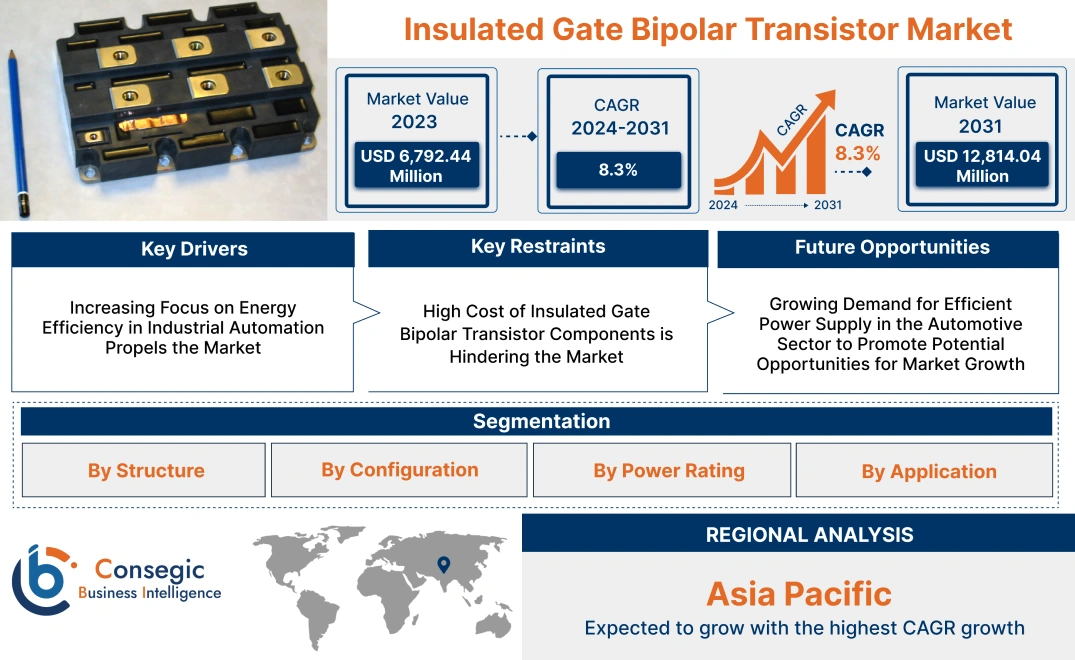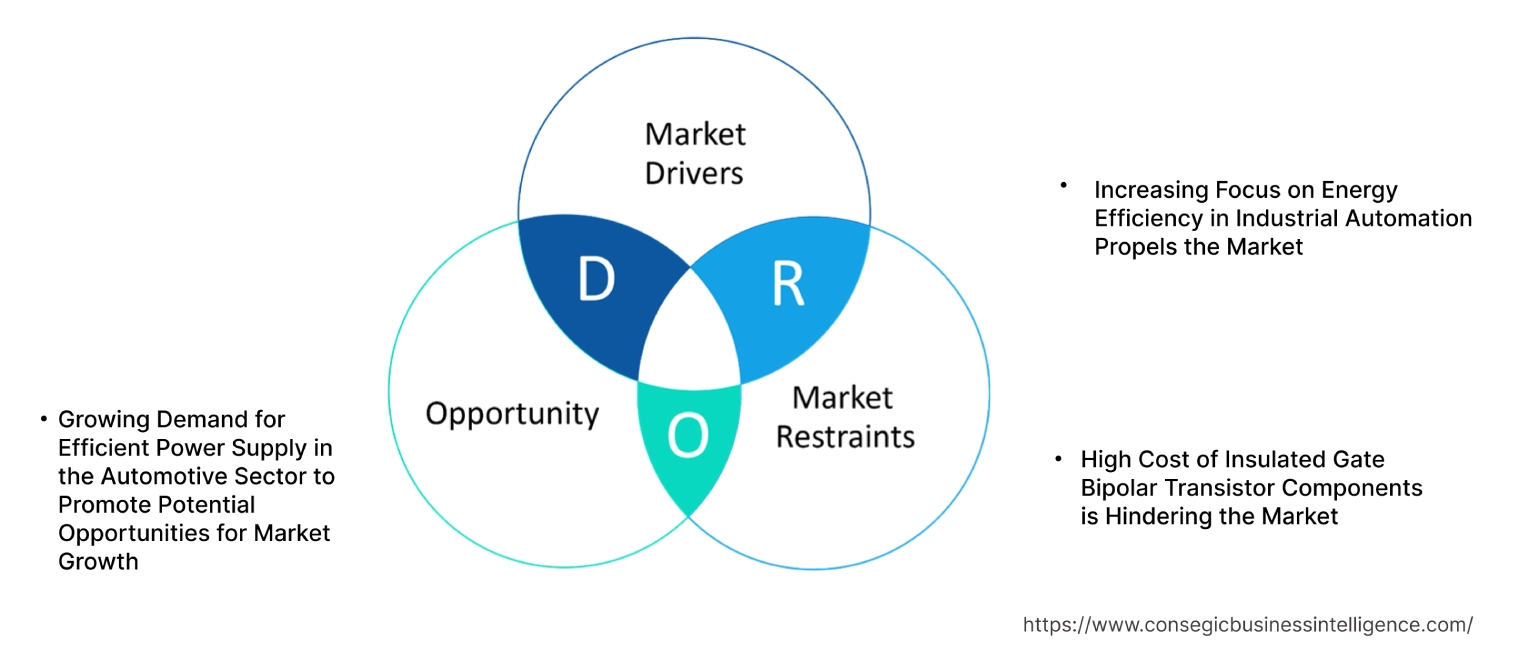- Summary
- Table Of Content
- Methodology
Insulated Gate Bipolar Transistor Market Size:
Insulated Gate Bipolar Transistor Market size is estimated to reach over USD 12,814.04 Million by 2031 from a value of USD 6,792.44 Million in 2023 and is projected to grow by USD 7,232.32 Million in 2024, growing at a CAGR of 8.3% from 2024 to 2031.
Insulated Gate Bipolar Transistor Market Scope & Overview:
An insulated gate bipolar transistor (IGBT) is a semiconductor device that combines the features of a bipolar transistor and a field-effect transistor (FET). It operates like a MOSFET (metal-oxide-semiconductor field-effect transistor) when it is turned on, allowing for efficient switching and minimal power loss. When it is off, it behaves like a bipolar transistor, allowing for high voltage and current handling capabilities. Additionally, it is widely used in power electronics for applications including motor drives, induction heating, and renewable energy systems. Moreover, it has the ability to handle high voltages, manage significant current, and provide fast switching times, allowing operate effectively for robust performance. The aforementioned features of insulated gate bipolar transistors are major determinants for increasing their deployment in automotive, manufacturing, energy and utilities, telecommunication, and other industries.
Insulated Gate Bipolar Transistor Market Insights:
Key Drivers:
Increasing Focus on Energy Efficiency in Industrial Automation Propels the Market
Industries strive to optimize operations and reduce energy consumption, there is a growing demand for advanced power electronic solutions. IGBTs can play a crucial role in applications such as motor drives, robotics, and process automation by enabling precise control over energy use. Additionally, the shift towards Industry 4.0 and the Internet of Things (IoT) is further driving the market, as connected systems require efficient power management to support smart devices and machinery. Manufacturers are increasingly looking for technologies that enhance efficiency, reliability, and performance, making IGBTs an attractive option for modern industrial applications.
- In March 2022, Infineon introduced P3000ZL45X168 with 4500V and 3000 A Press Pack IGBT. It features full long-term short-on-fail, explosion-proofed housing, the highest power cycling capabilities, and a wide range of clamping force. The modules are optimized for high switching frequencies, which improve energy conversion efficiency.
Therefore, the increasing focus on energy efficiency in industrial automation is fueling the insulated gate bipolar transistor market growth.
Key Restraints :
High Cost of Insulated Gate Bipolar Transistor Components is Hindering the Market
IGBTs are typically more expensive to manufacture compared to other semiconductor devices, including metal-oxide-semiconductor field-effect transistors (MOSFETs). This higher cost is largely due to the complex manufacturing processes involved in producing IGBTs, which require precise materials and advanced technologies to achieve their high performance and reliability. For many cost-sensitive applications, especially in developing regions or industries operating on tight budgets, the higher upfront investment for these transistors deters decision-makers from choosing them over more affordable alternatives.
Additionally, industries lean toward MOSFETs or other lower-cost solutions that, while potentially less efficient or powerful, provide a more economical choice for their specific needs. Moreover, the high costs limit the deployment of IGBT technology in smaller-scale renewable energy projects or less critical applications, where cost considerations often take precedence. Hence, the high cost of the transistor components poses a significant restraint in the insulated gate bipolar transistor market demand, impacting their adoption across various applications.
Future Opportunities :
Growing Demand for Efficient Power Supply in the Automotive Sector to Promote Potential Opportunities for Market Growth
The automotive landscape is undergoing a profound transformation, with a clear shift towards electric vehicles (EVs) and hybrid electric vehicles (HEVs). This transition presents a significant opportunity for Insulated Gate Bipolar Transistors (IGBTs) to become essential components in the power management systems of these vehicles. IGBTs enable efficient energy conversion and control, ensuring that EV powertrains operate at optimal performance levels while minimizing energy losses. Additionally, as automakers strive to enhance the range and efficiency of their electric models, the requirement for advanced IGBT technology is set to increase dramatically. IGBTs facilitate rapid switching capabilities, which are crucial for managing the high currents and voltages required in electric drive systems. Moreover, this allows for smoother acceleration, better energy recovery during braking, and improved overall vehicle performance.
- In August 2022, Renesas released Silicon IGBTs for Electric Vehicle Inverters for improved energy efficiency in automobiles. It provides a 10% reduction in power losses, helps save battery power, increases driving range, and maintains high robustness. It offers greater flexibility to design smaller inverters that achieve high performance.
Consequently, the analysis of market trends shows that the synergy between automotive and IGBT technology is anticipated to boost the insulated gate bipolar transistor market opportunities.
Insulated Gate Bipolar Transistor Market Segmental Analysis :
By Structure:
Based on structure, the market is segmented into non-punch through, punch through, and trench gate
Trends in the Structure:
- The trend towards higher voltage and power handling capabilities in industries like heavy-duty manufacturing, railways, and energy systems is pushing for the use of NPT IGBTs. Their ability to withstand high voltages and rugged conditions makes them a preferred choice in these sectors.
- PT IGBTs are seeing wider adoption in lower voltage applications, especially in consumer electronics and automotive powertrains. The trend is driven by the need for faster switching and lower conduction losses, making PT IGBTs more efficient in these applications.
The trench gate accounted for the largest revenue in 2023 and is anticipated to register the fastest CAGR during the forecast period.
- Trench gate structure features a trench structure that reduces conduction losses and enhances efficiency, preferred for high-power and high-frequency applications.
- It offers better power density, enabling smaller and more powerful systems, which is important in various sectors.
- Additionally, the need for precise control and efficient power management in industrial automation is driving the adoption of Trench Gate.
- For instance, STMicroelectronics introduced its Trench Gate Field-Stop IGBT, designed for industrial automation and high-performance motor control. This product improves the overall efficiency of industrial systems by offering reduced conduction and switching losses.
- Thus, the ability of trench gates to handle high power and frequency efficiently, is fueling the insulated gate bipolar transistor market growth.
By Configuration:
Based on configuration, the market is segmented into discrete IGBT and IGBT modules.
Trends in the Configuration:
- As consumer electronics evolve towards more compact and portable designs, there is an increasing need for discrete IGBTs that can handle specific, small-scale applications efficiently, such as in light-duty motor controls.
- With the surge in Industry 4.0 and automated manufacturing, IGBT modules are playing a key role in driving large industrial motors, robotics, and process automation systems, supporting high-efficiency operations in these sectors.
The IGBT modules accounted for the largest revenue of the total insulated gate bipolar transistor market share in 2023 and are anticipated to register the fastest CAGR during the forecast period.
- IGBT modules incorporate multiple insulated gate bipolar transistor units within a single module, allowing for greater power density.
- It is primarily used in sectors that require compact and efficient power management solutions.
- The performance advantages of IGBT modules in terms of reduced switching and conduction losses make them the preferred choice for applications requiring efficient energy conversion and management.
- In April 2021, Infineon launched its EasyPACK 2B IGBT module integrated with CoolSiC MOSFETs, designed for high-power applications in renewable energy systems and industrial drives. This module offers improved thermal performance and efficiency, making it suitable for severe applications.
- Hence, as per the analysis the aforementioned factors of IGBT modules are propelling and are anticipated to boost the insulated gate bipolar transistor market trends.
By Power Rating:
Based on power rating the market is segmented into low power, medium power, and high power.
Trends in the Power Rating:
- Medium voltage IGBTs are increasingly used in solar inverters and wind turbine systems, facilitating the integration of renewable energy sources into the grid.
- Continuous innovation in power electronics is leading to the development of high-voltage IGBTs that offer improved efficiency, higher switching speeds, and better performance under extreme conditions.
The medium voltage accounted for the largest revenue share of 47.22% of the overall insulated gate bipolar transistor market share in 2023.
- The medium voltage transistors range between 600V and 1700V, extensively used in industrial automation where they provide efficient power control for motor drives, conveyors, and robotic systems.
- It is also becoming a critical component in electric vehicles, particularly for medium-duty applications, contributing to the electrification of transportation.
- For instance, Toshiba introduced MG600Q2YMS3 and MG400V2YMS3 medium voltage IGBT modules. It aimed at providing higher efficiency in industrial equipment for railway vehicles and renewable energy systems. These modules enhance the efficiency and reliability of power conversion processes in renewable energy sources.
- Overall, the role of medium voltage IGBT in renewable energy and industrial applications is collectively driving the insulated gate bipolar transistor market demand.
The high voltage is anticipated to register the fastest CAGR during the forecast period.
- High voltage IGBT range above 1700V, essential for high power applications including automotive and large industrial machinery.
- It enables efficient power management, optimized power density, and facilitates conversion and transmission for high voltage power.
- In April 2023, Mitsubishi introduced the High Voltage IGBT X-Series dual-type Module. It is particularly designed for railway traction, motion control, and power transmission systems. This module is optimized for high power density and reliability, contributing to improved energy efficiency in electrical infrastructure.
- Consequently, according to the analysis these factors indicate that high voltage IGBTs are positioned for significant growth of the insulated gate bipolar transistors market trends during the forecast period.
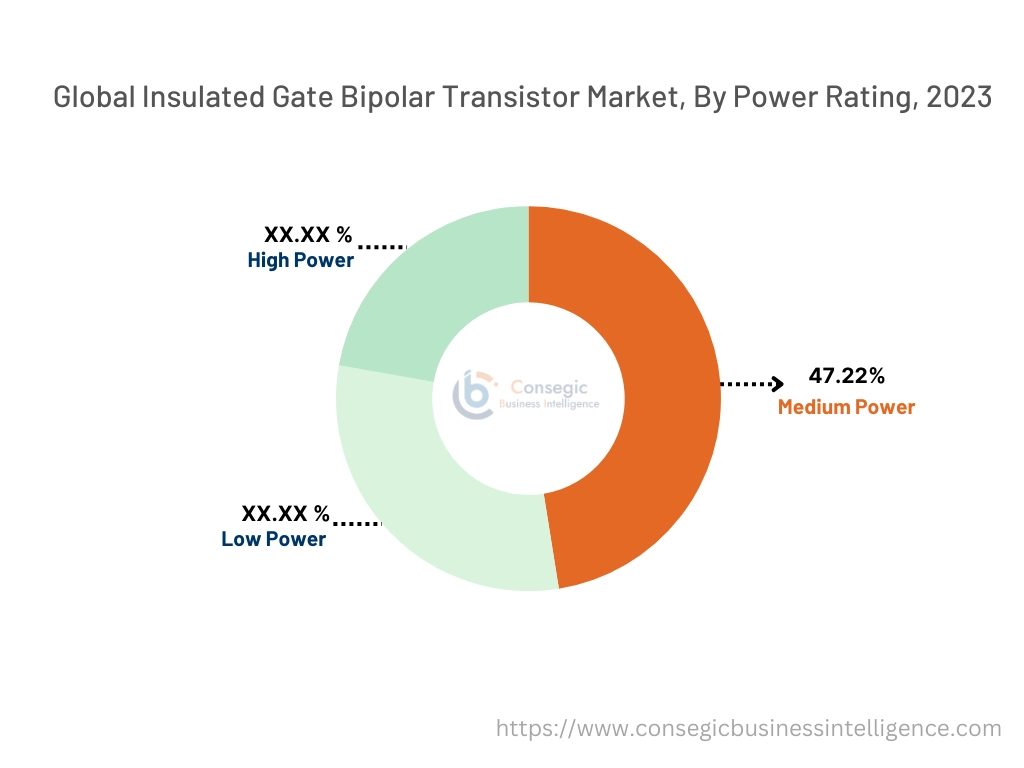
By Application:
Based on application, the market is segmented into industrial, residential, automotive, renewables, and others.
Trends in the Application:
- The trend toward smaller, more compact consumer electronics is driving the requirement for IGBTs with lower power loss and higher efficiency, facilitating the production of sleek, energy-efficient devices.
- The shift toward more energy-efficient and environmentally friendly rail systems is driving IGBT use in electric trains and high-speed rail systems. IGBTs provide better energy management, lower emissions, and optimized performance.
- There is a growth in using silicon carbide (SiC) and gallium nitride (GaN) technologies as alternatives to IGBTs in certain high-performance applications, especially in electric vehicles.
The industrial accounted for the largest revenue share in the year 2023 and is anticipated to register the fastest CAGR during the forecast period.
- The industrial segment covers applications in manufacturing, process control, and large-scale automation systems, where IGBTs play a crucial role in motor drives, robotics, and heavy machinery.
- Industries are focused on reducing energy consumption and improving operational efficiency. IGBTs enable precise control and energy savings in various industrial applications.
- Additionally, the trend towards smart manufacturing and Industry 4.0 initiatives further enhances the role of IGBTs in industrial applications, as they facilitate the integration of advanced control systems and IoT technologies.
- For instance, Schneider introduced the Altivar Process ATV600, an industrial drive featuring IGBT technology designed for process automation. This solution helps optimize energy consumption and reduce operational costs in manufacturing environments.
- Hence, as per the analysis aforementioned industrial application is proliferating the insulated gate bipolar market trends.
Regional Analysis:
The regions covered are North America, Europe, Asia Pacific, the Middle East and Africa, and Latin America.
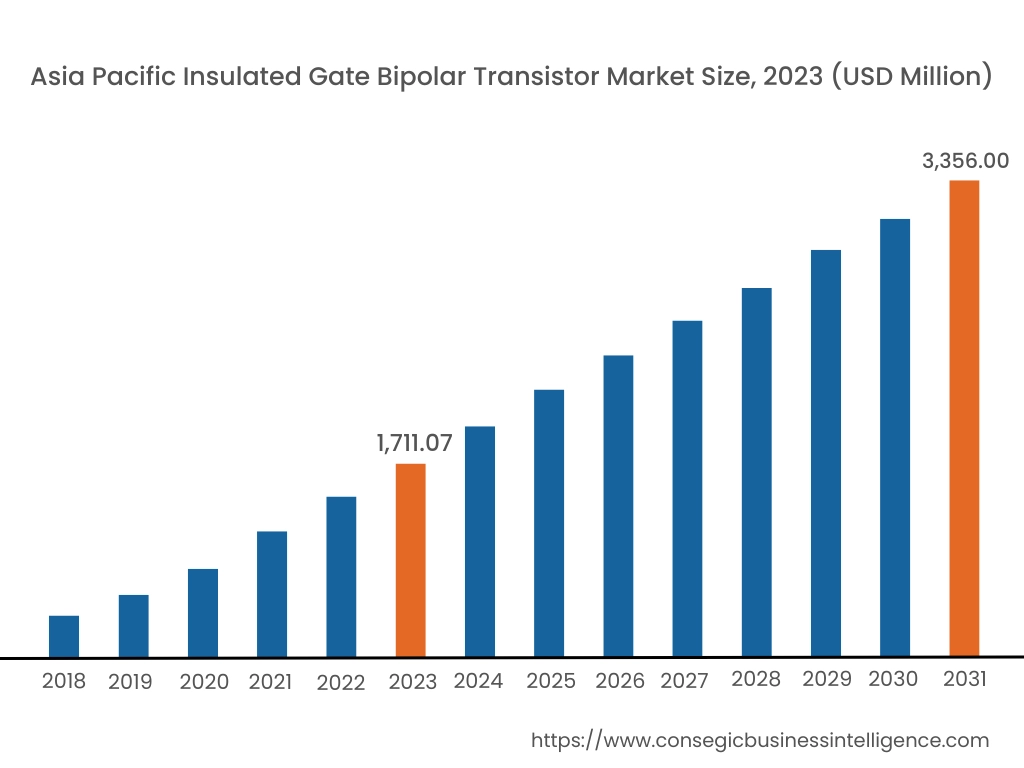
Asia Pacific region was valued at USD 1,711.07 Million in 2023. Moreover, it is projected to grow by USD 1,827.90 Million in 2024 and reach over USD 3,356.00 Million by 2031. Out of this, China accounted for the maximum revenue share of 31.3%. As per the insulated gate bipolar transistor market analysis, the Asia-Pacific region is experiencing rapid industrialization, which is significantly driving the need for medium and high-voltage IGBTs in diverse applications. Countries including China, Japan, and South Korea are at the forefront of producing semiconductor chips, creating substantial opportunities for high-voltage IGBTs. Additionally, significant investments in renewable energy projects, such as solar farms and wind energy installations, further contribute to the growth of IGBT adoption in this region. As industries continue to expand, the Asia-Pacific market is set to play a pivotal role in shaping the future of IGBTs.
- In June 2021, Mitsubishi Electric Corporation unveiled a T-series 2.0kV Insulated Gate Bipolar Transistor module designed specifically to cater to industrial needs. The module is well suited to high voltage to increase the efficiency and reduce the size of renewable-energy power supplies.
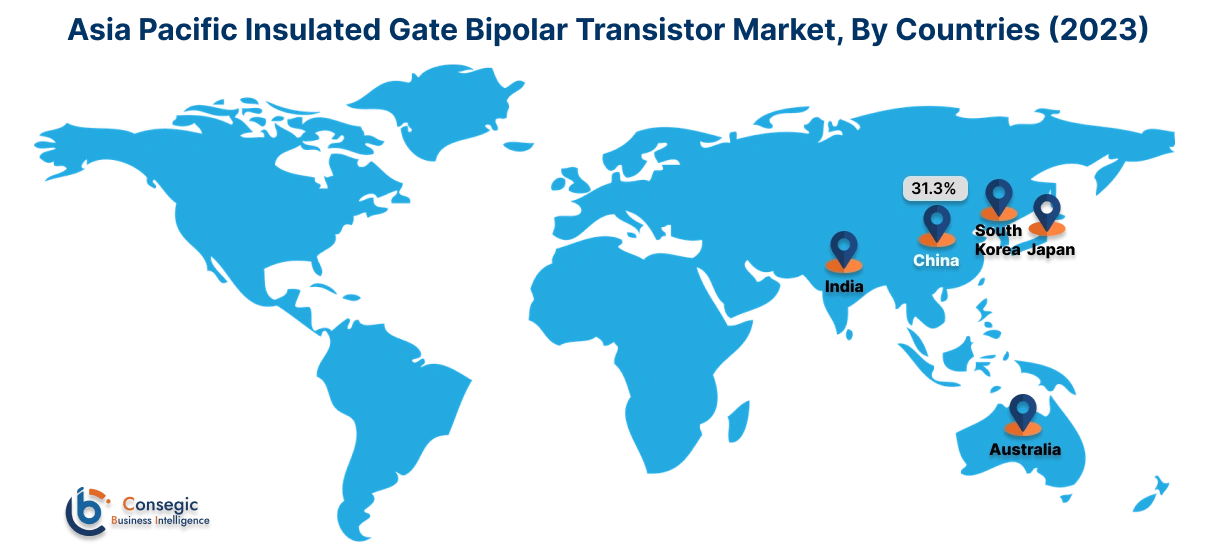
North America is estimated to reach over USD 4,304.24 Million by 2031 from a value of USD 2,262.90 Million in 2023 and is projected to grow by USD 2,411.10 Million in 2024. North America holds a significant share of the insulated gate bipolar transistor market expansion, driven by advanced industrial automation and a robust presence of key players. The region is witnessing rapid growth in the electric vehicle (EV) market, which significantly boosts the demand for high-voltage IGBTs, essential for efficient power management in EV powertrains. Additionally, increased investments in renewable energy infrastructure, including solar and wind projects, further support the adoption of medium and high-voltage IGBTs, as they play a crucial role in energy conversion and grid integration.
Europe is characterized by a strong emphasis on sustainability and energy efficiency, leading to a growing need for IGBTs across various applications, particularly in electric vehicles and renewable energy systems. Government policies promoting green technologies and initiatives aimed at reducing carbon emissions enhance the adoption of IGBTs throughout the region, enhancing the insulated gate bipolar transistor market expansion.
The insulated gate bipolar transistor market analysis shows that the Latin American market for IGBTs is emerging, fueled by increasing interest in renewable energy projects and industrial automation. As governments in the region implement supportive initiatives to enhance energy efficiency, the demand for IGBTs is expected to rise.
In the Middle East and Africa, ongoing infrastructure development projects are expected to create significant insulated gate bipolar transistor market opportunities, especially in power generation and distribution applications. The region's efforts to diversify energy sources, including an increased focus on renewable energy, will drive demand for medium and high-voltage IGBTs.
Top Key Players & Market Share Insights:
The insulated gate bipolar transistor market is highly competitive with major players providing optimized energy transmission to the national and international markets. Key players are adopting several strategies in research and development (R&D), product innovation, and end-user launches to hold a strong position in the global insulated gate bipolar transistor market. Key players in the insulated gate bipolar transistor industry include-
- Infineon Technologies AG (Germany)
- Mitsubishi Electric Corporation (Japan)
- STMicroelectronics (Switzerland)
- Vishay Intertechnology (USA)
- Semikron (Germany)
- Nexperia (Netherlands)
- ON Semiconductor (USA)
- Fuji Electric Co., Ltd. (Japan)
- Renesas Electronics Corporation (Japan)
- Hitachi, Ltd. (Japan)
- Toshiba Corporation (Japan)
- AOS (USA)
- IXYS Corporation (USA)
- Texas Instruments (USA)
Recent Industry Developments :
Product Launch:
- In May 2024, Power Integrations Launched SCALE-iFlex XLT, single board plug and-play gate drivers for high voltage IGBT modules. This driver enables active thermal management of inverter modules to improve system utilization and increase reliability.
- In April 2024, Fuji Electronics launched HPnC Series Large-Capacity Industrial IGBT Modules. It is designed for applications including power converters for solar and wind power generation systems. These products improve the capacity and reduce the overall size of the power converters.
- In July 2023, Rockwell Automation unveiled its ArmorKinetix® Distributed Servo Drives, an extension of the Kinetix 5700 platform. It utilizes IGBT technology to enhance industrial automation control systems in industrial robotics, providing precise and efficient motor control for automated processes.
- In April 2023, Infineon launched HybridPACK Drive G2 an automotive power module for traction inverted in electric vehicles. The module provides voltage levels of 750V and 1200V with high performance and power density through improved assembly and interconnect technology.
Product Expansion:
- In July 2024, Magnachip Semiconductor Corporation expanded its solar energy power product lineup with the launch of the 1200V 75A Insulated Gate Bipolar Transistor. This product is suitable for applications requiring high power rating and high efficiency including solar inverters, converters, uninterruptible power supply systems, and general-purpose inverters.
- In January 2023, Infineon expanded its TrenchStop IGBT7 series, optimized for industrial motor drives. This series focuses on reducing power losses, enhancing efficiency, and supporting high switching frequencies, making it ideal for industrial automation and robotics.
Insulated Gate Bipolar Transistor Market Report Insights :
| Report Attributes | Report Details |
| Study Timeline | 2018-2031 |
| Market Size in 2031 | USD 12,814.04 Million |
| CAGR (2024-2031) | 8.3% |
| By Structure |
|
| By Configuration |
|
| By Power Rating |
|
| By Application |
|
| By Region |
|
| Key Players |
|
| North America | U.S. Canada Mexico |
| Europe | U.K. Germany France Spain Italy Russia Benelux Rest of Europe |
| APAC | China South Korea Japan India Australia ASEAN Rest of Asia-Pacific |
| Middle East and Africa | GCC Turkey South Africa Rest of MEA |
| LATAM | Brazil Argentina Chile Rest of LATAM |
| Report Coverage |
|
Key Questions Answered in the Report
What is an insulated gate bipolar transistor? +
Insulated gate bipolar transistor (IGBT) is a semiconductor device that combines the features of a bipolar transistor and a field-effect transistor (FET). It operates like a MOSFET (metal-oxide-semiconductor field-effect transistor) when it is turned on, allowing for efficient switching and minimal power loss. When it is off, it behaves like a bipolar transistor, allowing for high voltage and current handling capabilities.
How big is the insulated gate bipolar transistor market? +
Insulated Gate Bipolar Transistor Market size is estimated to reach over USD 12,814.04 Million by 2031 from a value of USD 6,792.44 Million in 2023 and is projected to grow by USD 7,232.32 Million in 2024, growing at a CAGR of 8.3% from 2024 to 2031.
What is the key market trend? +
The shift toward more energy-efficient and environmentally friendly rail systems is driving IGBT use in automotive. IGBTs provide better energy management, lower emissions, and optimized performance.
Who are the major key players in the insulated gate bipolar transistor market? +
The major key players in the insulated gate bipolar transistor market are Infineon Technologies AG (Germany), Mitsubishi Electric Corporation (Japan), Fuji Electric Co., Ltd. (Japan), STMicroelectronics (Switzerland) Vishay Intertechnology (USA), Semikron (Germany), Nexperia (Netherlands), ON Semiconductor (USA), Texas Instruments (USA), Renesas Electronics Corporation (Japan), Hitachi, Ltd. (Japan), Toshiba Corporation (Japan), AOS (USA), IXYS Corporation (USA) and other.
